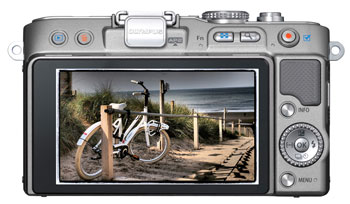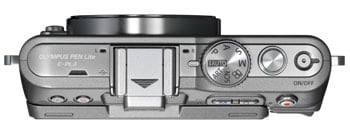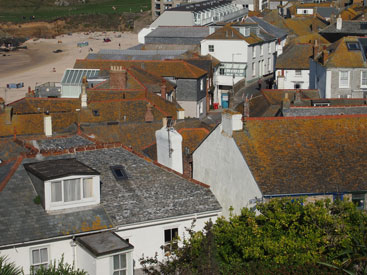Olympus E-PL3
-
-
Written by Gordon Laing
Intro
Olympus launched its Pen range of Micro Four Thirds mirrorless interchangeable lens cameras (ILCs) with the E-P1 in 2008. Announced in June 2011 the Pen E-PL3 is the third generation of the range that melds the company’s iconic 60’s design with 21st century digital imaging technology. Nicknamed the ‘Pen Light’ the E-PL3 is a smaller, lighter and simpler version of the Pen flagship E-P3 and is now also joined by a third Pen, the entry-level E-PM1, also known as the Pen Mini.
With the E-PL3, the company has taken a step away from the classic Pen style of the earlier models. It’s significantly smaller, though not much lighter than its predecessor and sports a new 16:9 flip-up screen and a redesigned 12.3 Megapixel sensor. The built-in flash is gone, replaced by a clip-on unit and there’s a new AF assist lamp to augment the capabilities of the improved 35-point contrast detect AF system.
The E-PL3 can shoot 1080i60 video in AVCHD format and improves on the E-PL2’s continuous shooting with a top speed of 5.5 frames per second. With built-in sensor-shift image stabilisation and an ISO sensitivity range that now extends to 12800 ISO its low light performance is considerably improved.
Like Both Panasonic and Sony, Olympus has its sights firmly set on migrants looking for a richer photography experience than their point-and-shoot can offer. But it’s no easy thing designing a range that includes models for everyone, particularly in the middle ground, where both ease of use and advanced features must cohabit in harmony. Has Olympus got the mix right with the E-PL3, or is the Panasonic Lumix GF3 or the Sony Alpha NEX-C3 a better fit for both compact snappers looking to trade up and enthusiasts in search of advanced features in a more compact form. Read our full review to find out.
 |
Olympus Pen E-PL3 Design and controls
Though not appreciably lighter than its predecessor, the Pen E-PL3 is significantly smaller. But more than the reduction in size, it’s the redesign that sets it apart. Gone is the retro Pen styling, replaced by a sleek modern compact look. Its interesting how both Panasonic with the Lumix GF3 and Olympus with the E-PL3 seem to be going in similar directions style-wise.
 |
Despite the flip-up screen the E-PL3 is a slimmer camera than the E-PL2, with no built-in flash. Borrowing from the Sony NEX design, Olympus has slimmed the body by extending the lens mount on the front panel. The other thing noticeable by its absence is the front grip. Demoted on the E-P3 to a clip-on accessory, it’s disappeared from the E-PL3 altogether leaving the front plate a featureless lacquered expanse. The E-PL3 isn’t as comfortable in the hand as the E-PL2 was, but it’s undeniably better looking.
On the rear a new thumb pad makes for a better grip and all the physical controls from the earlier model are there, albeit rearranged in an improved layout made possible by the angled panel that forms a transition between the top and rear surfaces. To the left side of the accessory port are the playback and delete buttons and on the other are the Function button and magnifier plus the dedicated movie record button. Below the thumb pad is the four-way control wheel flanked top and bottom by info and menu buttons. One other thing that is worthy of mention at this point is that the E-PL3 retains its physical mode dial, a feature neither the Sony NEX-C3 nor the Lumix GF3 can lay claim to and something that may be a deciding factor if you like to experiment with different exposure modes.
The move from a 3:2 aspect ratio screen to a 16:9 one will be seen by many as a retrograde step, but being able to flip the screen either up or down, NEX-style is a marked improvement. While it doesn’t help with portrait shooting I found being able to flip the screen up improved visibility in bright conditions as well as being more comfortable when shooting from low angles. But it also needs to be said that, though it’s ideal for movie shooting, for 4:3 aspect ratio stills shooting a significant portion of the screen is unused resulting in large black bars down either side of the screen.
 |
Though the E-PL3 doesn’t have an optical viewfinder both optical and electronic viewfinders are available as hotshoe mounted accessories that plug into the AP2 accessory port just below the hotshoe in the rear panel. The supplied external flash slides in here without any of the fiddling around involved with the NEX-C3 one, then it flips up for use. A guide number of 10 at 200 ISO gives it a range of 2.8 metres with the f3.5-5.6 kit lens at its widest angle setting and maximum aperture – exactly the same as the Sony NEX-C3’s supplied external flash. The E-PL3 is also compatible with Olympus’ FL36R and FL50R wireless flash units.
The E-PL3 has a combined battery/card compartment on the base of the camera. As well as the supplied BLS-1 Li-Ion battery it’s compatible with the older BLS-5 models. The battery life is quoted at 330 shots using the CIPA standard testing methods. The E-PL3 is compatible with SD, SDHC and SDXC memory cards and cards with a speed class of at least 6 are recommended for movie recording.
Olympus Pen E-PL3 lens and stabilisation
We tested the E-PL3 with the M. Zuiko Digital 14-42mm f3.5-5.6 II R MSC kit zoom lens. The R stands for ‘Renewed’, but aside from some cosmetic differences this is essentially the same kit lens as boxed with the E-PL2. It has a retracting design which makes it reasonably compact, especially compared with the stabilised kit zooms for the Sony NEX-C3 and Lumix GF3. Micro Four Thirds lenses have a crop factor of two, making the 35mm equivalent range 28-84mm
Olympus Pen E-PL3 with 14-24mm coverage wide | Olympus Pen E-PL3 with 14-42mm coverage tele | |
 |  | |
| 14-42 mm at 14mm (28mm equivalent) | 14-42mm at 42mm (84mm equivalent) |
Like all Pen models, the E-PL3 body is fitted with sensor-shift image stabilisation. There are three modes, 1 works on both axes, 2 is vertical only, for panning shots and 3 is horizontal only, for portrait mode panning.
I tested the E-PL3’s stabilisation by zooming the kit lens to its maximum 42mm (84mm equivalent) focal length and taking a series of hand-held shots at progressively slower shutter speeds with the camera in Shutter priority exposure mode, first with the stabilisation turned off, then set to mode 1 (both horizontal and vertical stabilisation).
Olympus E-PL3 14-42mm f3.5-5.6 IS Off/On (mode 1) | ||||
 |  | |||
100% crop, 14-42mm at 42mm, 200 ISO 1/10th, IS off. | 100% crop, 14-42mm at 42mm, 200 ISO 1/10th, IS on. | |||
The crop on the left is from the shot with IS turned off and the one on the right is with it turned on in mode 1. The stabilised crop looks a tiny bit soft so camera shake hasn’t been completely eliminated but I’ve used this example rather than the sharper 15th of a second crop because I think it’s just about acceptable. Also, the final gallery shot which was hand-held at 1/6th of a second demonstrates that the E-PL3 is capable of three stops of stabilisation.
Olympus Pen E-PL3 shooting modes
In addition to PASM modes the E-PL3 has point and Shoot iAuto mode with scene detection. Olympus pioneered results-based controls and so it’s no surprise to see Live Guide controls appear when you press the centre button on the control wheel. The E-PL3 also has another Olympus innovation that’s been adopted in one form or another by both Sony and Panasonic, Art filters. The E-PL3 has the same 6 art modes as the E-PL2 – Pop Art, Soft Focus, Grainy Film, Pin Hole, Diorama, and Dramatic Tone – but the customisation options have been extended with a wider choice of filter effects and framing.
 |
The PEN E-PL3 mode dial has a movie position which provides a full screen 16:9 view so you can frame up your shot properly. You can argue the pros and cons of a 16:9 screen, but being able to use the full screen area to frame shots prior to shooting at least makes the most of it.
In PASM modes the E-PL3 provides good access to exposure settings which are activated by pressing the up position on the control wheel. In Program auto mode you can then shift the aperture/shutter speed combination either by up/down pushes on the control wheel or by rotating it, with exposure compensation achieved by pushing the left/right positions. This quickly becomes second nature and the only thing that gets in the way, literally, is the control wheel’s proximity to the protruding right edge of the flip-up screen. With similar setups for the semi automatic and manual exposure modes, while it lacks the E-P3’s thumbwheel, you always feel in full control of exposure.
Olympus Pen E-PL3 movie modes
The E-PL3’s best quality movie mode is 1080i60 which is encoded as an AVCHD file at an average bitrate of 17Mbps. There’s also a 13Mbps option at the same resolution and two 720p settings at 17Mbps and 13Mbps. Finally, there’s a 720p option that records editing-friendly Mjpeg files at 30fps and a standard resolution 640×480 mode.
Movies can be shot in any of the PASM modes and with the Art filters either by selecting the required mode on the dial then pressing the record button, or by selecting movie mode on the dial and choosing the exposure mode from the Live Control menu. In manual exposure mode, you also have manual control over ISO sensitivity, which in the other modes is fixed on auto. While it’s great to have the option of shooting movie footage using the Art filters (you can see an example of the miniature Art filter in action in our Olympus E-P3 review) many of them result in slow jerky playback at severely reduced frame rates. You can shoot still a image during movie recording (though recording stops, then a new clip is started) and there’s an option to automatically take a shot at the end of each clip.
| |
|---|---|
|
The E-PL3’s slighly warm colour bias is also evident on video footage. The focus gets a bit lost on the zoom out, but recovers in the end. The worrying frame wiggle just before the zoom out could be a stabilisation artifact.
| |
|---|---|
|
The auto exposure and white balance is very responsive on this tripod mounted panning shot, but some consistency might have been less distracting. Like the NEX-C3 and GF3, the E-PL3’s CMOS sensor isn’t troubled by bright water reflections.
| |
|---|---|
|
Again, the Pen EPL-3’s exposure, white balance and focus are constantly at work in this interior hand-held panning shot to keep everything on track.
Olympus Pen E-PL3
handling
The E-PL3 is very quick off the blocks, being ready to shoot well within a second of pressing the on/off button. If you turn it on, then press the shutter button there’s only a moment’s hesitation before it fires – providing of course you’ve already extended the kit zoom.
Olympus has made much of the improved AF speed of the third generation Pens and the E-PL3 is noticeably quicker than its predecessor, not to mention more sophisticated with 35 AF regions compared with 11 previously. As before you can let the camera select the AF region automatically, or choose one yourself by pressing the left button on the control wheel. The inclusion of an AF assist lamp on the front panel improves it’s low-light AF performance and you can focus manually, though the magnification options don’t work at seamlessly as they might.
 |  |  |
I’ve already talked about how the physical mode dial makes direct access to exposure modes much easier than on models like the Lumix GF3 and NEX-C3, and the E-PL3 shares the accessible and highly customisable interface of its higher end sibling the E-P3. The Live Control shortcut menu displays appropriate options for the current shooting mode on the right of the screen with available settings for the selected option arrayed along the bottom of the screen.
Buried away in the custom menu is an option that’s disabled by default, but worth tracking down if you like to have your control cake, with icing on, and eat it. The aptly named Super Control panel is a single screen that provides access to everything that matters from ISO and White balance to Gradation and colour space. You simply select the required setting from the grid and use the control wheel to cycle through the options. Having it all on one screen isn’t as overwhelming as you’d imagine and it means not having to hunt through menus looking for a setting if you’re not sure where to find it. Plus you can toggle between the Live Control and SCP view by pressing the info button.
The Pen series has quickly gained a reputation for being highly customisable and with four custom buttons the E-PL3 can quickly be moulded to suit your personal shooting style. You can even allocate the movie record button to a custom function in which case the shutter release becomes the record button, the only drawback of this setup being that you sacrifice one-touch movie recording as you must first select movie move on the mode dial.
An improved continuous shooting rate of 5.5 frames per second puts the E-PL3 ahead of the Lumix GF3 and on an equal footing with the NEX-C3. Unlike the Lens-stabilised NEX-C3 the Olympus E-PL3’s sensor-shift stabilisation does have an effect on sequential shooting rates. In the E-PL3’s fastest sequential shooting mode which locks the focus on the first frame we shot a burst of 9 best quality jpegs at 4.7fps with the image stabilisation set to 1 (horizontal and vertical stabilisation). With the stabilisation turned off, that increased to an impressive 6.2 fps.
The E-PL3’s newly designed 12.3 Megapixel Four Thirds sensor produces 4:3 images with a maximum size of 4032 x 3024 pixels. Images can be saved as RAW data files or as compressed JPEGs at one of two compression settings. Best quality JPEGs have a file size of between 4 and 6MB. The ISO sensitivity ranges from 200 to 12800 ISO and the shutter speed range is from 60 seconds to 1/4000.
To see how the quality of the Olympus Pen E-PL3 measures-up in practice, take a look at our real-life resolution and high ISO noise results pages, browse the sample images gallery, or skip to the chase and head straight for our verdict.




